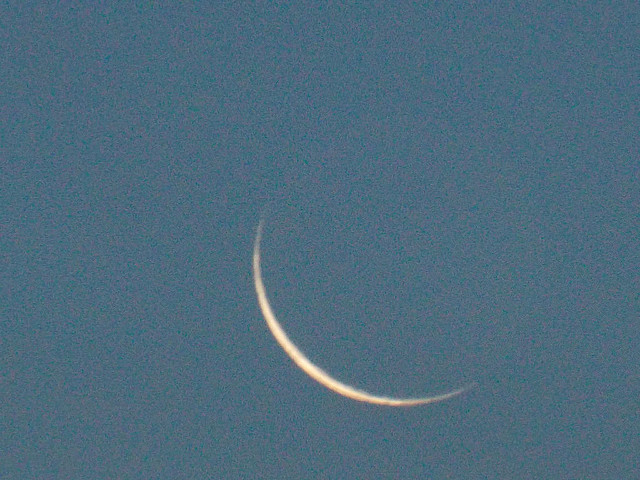

A razor thin Moon from October 22nd, 2014. Image credit and copyright: David Blanchflower.
This Halloween weekend’s top astronomical event features something that you won’t see in the sky.
By now, you’ve probably seen the stories circulating ’round ye ole web about how this month features a ‘Black Moon.’ The internet seems to love promulgating the passing of such curious calendrical oddities as Moons both Black, Blue and otherwise.
What’s all of the hoopla about? Well, simply put, the Moon reaches New phase this weekend on October 30th at 17:38 Universal Time (UT), marking the start of lunation 1161. This is the second New Moon for the month, as the first fell on October 1st, just 11 minutes into the month as reckoned in Universal Time.
Now, this isn’t at all rare or unusual; the synodic period of the Moon (that is, the time it takes to return to a similar phase, such as New back to New) is 29.5 days long, a period that shoehorns well in to a 31 day month like October, or occasionally, a 30 day month.
More Fun With Calendars
February is the only month that cannot contain a ‘repeat phase,’ leap year or no. Occasionally, a given phase such as New or Full can be absent from short February all together… sometimes, this oddity is also sometimes referred to as a ‘Black Moon.’ 2014 and 2033 are the nearest years to 2016 that are missing New Moons in February.
And then there’s the relict definition of a Blue Moon as the ‘3rd in an astronomical season with 4…‘ that can also be ascribed to a Black Moon as relates to New phase, as if we already lack enough multi-hued Moons in or lives.
Keep in mind, the moment of New is but an instant, a point a which the Moon’s longitude along the ecliptic plane equals the Sun’s. The Moon makes a miss of the Sun on most lunations, and only directly passes between the Sun and the Earth during an annular or solar eclipse. We’ve got one each coming up in 2017: an annular solar eclipse crossing the southern tip of South America on February 26th, and the historic return of totality to the United States on August 21st, 2017.
Said high profile solar eclipse next August also has a lesser role, as it fits that old-timey definition of the 3rd New Moon in an astronomical season with four. Of course, this is only the juxtaposition of the lunar cycle on our current Gregorian calendar, using time reckoned in UT/GMT.
Don’t fear the Black Moon. This year’s New Moon just misses Halloween. The next New Moon on Halloween (which, of course, is always a ‘Black Moon’) occurs in 2035.
And we’ll let you in on a secret: astronomers don’t spend nights in mountaintop observatories discussing Black or Blue Moons… the term has more of an astrological tinge to it. Even in amateur astronomy circles, you sometimes hear the term ‘the dark of the Moon’ used to refer to the weeks surrounding New Moon, a prime time for deep sky astrophotography.
Looking for a New Moon-related observing challenge? Spotting the razor thin waxing or waning Moon is a fun feat of visual athletics. Look for a thin waning crescent Moon hanging near Jupiter on the morning of Friday, October 28th. This weekend, the first shot at catching the uber-thin Moon occurs for observers along a curve from southeastern Asia at dusk on October 31st westward at dusk. For Spain (and Astroguyz basecamp) the Moon will be 24 hours past New, and for the United States, the Moon will be 28 to 32 hours old at sunset for roaming Halloween ghouls and goblins, an easy catch.
A time change is also afoot this weekend, as folks in Europe and the UK ‘fall back’ one hour to standard time. This setback falls nearly as late as it can in 2016, and we now enter that wacky oneeek period where the world slowly slips back to standard time. Blame ‘Big Sugar’ for the latency in most of North America, as prospective trick-or-treaters now make their rounds during daylight hours. In most of the US and Canada, the switch occurs on Sunday, November 6th.
And there’s one more astronomical tie-in for Halloween: the holiday traces its roots back as one of the four cross-quarter days of yore, including Lammas Day, Groundhog Day, and May Day. Of course, the fixing of Hallow’s Eve on October 31st makes the midway date only approximate: in 2016, the actual mid-point occurs on November 10th.
Out of this world stuff to consider, as you inventory the night’s sugary bounty and contemplate the night sky.
December 3rd, 2018, NASA's Origins, Spectral Interpretation, Resource Identification, and Security?Regolith Explorer (OSIRIS-REx) successfully rendezvoused…
The Andromeda Galaxy, our nearest large neighbour, has 36 identified dwarf galaxies. The Hubble telescope…
Rogue planetary-mass objects, also known as free-floating planets (FFPs) drift through space alone, unbound to…
The effects of Climate Change on Earth's living systems have led to a shift in…
Our Milky Way Galaxy is rich in dark matter. The problem is, we can't see…
Neutrinos generated through solar fusion reactions travel effortlessly through the Sun's dense core. Each specific…